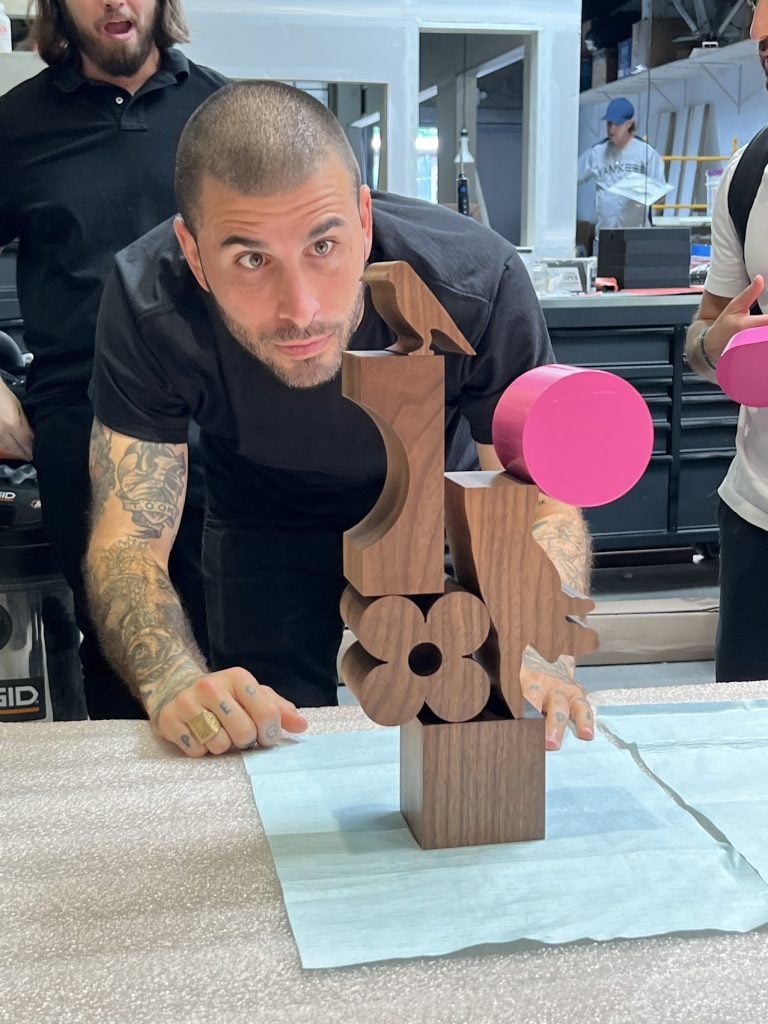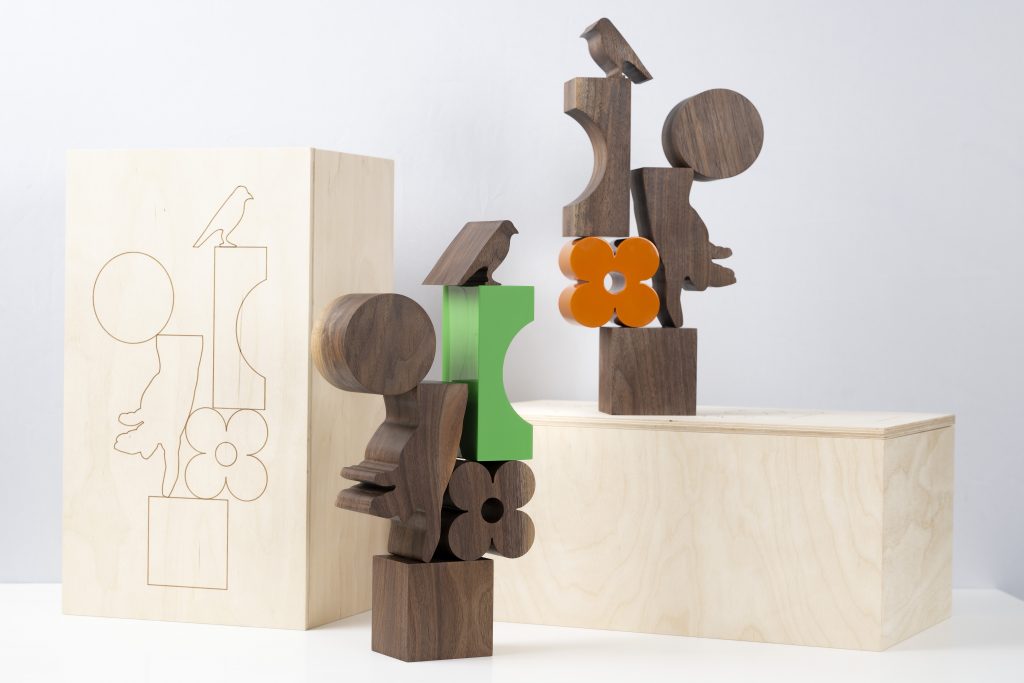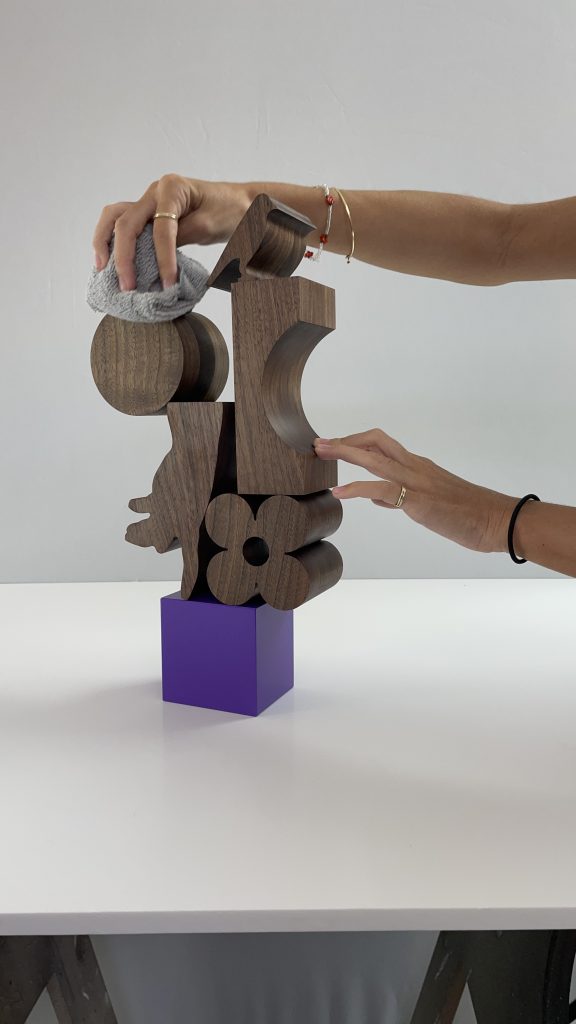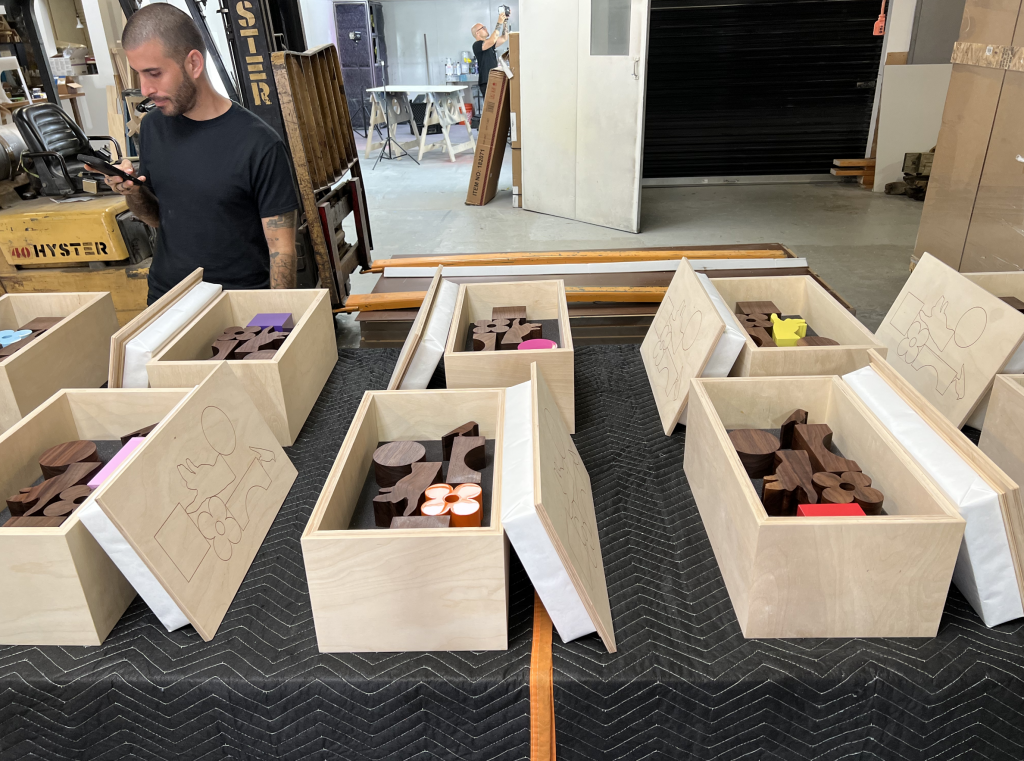Artnet Auctions
Miami Artist Typoe Talks Us Through His New Sculpture Series, Now Live on Artnet’s Buy Now Platform
The gravity-defying sculptures look playful, but speak to the fragility of life.

The gravity-defying sculptures look playful, but speak to the fragility of life.

Samantha Baldwin

Typoe Gran is taking a page from Friedrich Fröbel’s book. The Miami-based artist has long been inspired by the inventor of kindergarten and building blocks, creating larger-than-life sculptures and murals that remind us of the importance of play and experimentation.
Typoe, who recently made news for his major artistic contribution to the Andy Warhol Museum’s Pop District, has been creating his own lexicon of building blocks for the past several years. His visual language stretches far beyond the cubes, spheres, and archways Fröbel introduced in the 1830s, to flowers, hands, skulls, blood drops, and ravens—all of which hold a unique, symbolic meaning.
Artnet’s current Buy Now sale features By the Grace of God, a collection of brand-new balanced sculptures, each with a unique element of color. We sat down with Typoe to learn about the inspiration behind this title, the process behind the works, and where he sees his visual language heading in the future.
Read on to learn more, and bring home one of Typoe’s sculptures, available for immediate purchase through August 16.

Typoe, By the Grace of God, 2022. These sculptures are available for immediate purchase on Artnet’s Buy Now platform.
When did you realize that you wanted to create art? Was this something you’ve always been interested in, or did it come to you later on?
My mom is an artist, my older sister is an artist, and my great-aunt used to carve sculptures from marble using a chisel and a hammer. I grew up around a lot of creative female artists. My parents also collect art, so I’ve always been surrounded by it.
I have been making things since I could crawl, always just intuitively building. The first sculpture I ever made was created by taking two teddy bears, cutting them in half, and putting them back together to form one new bear. I remember thinking it was interesting to bring the two different concepts together.
My parents saved most of my art from when I was a kid, so they have my drawings and stories and clay sculptures—everything. I can look back and see a lot of similarities from then to now, even in terms of content. Some of it was bright and fun, but a lot of it was really dark for a kid.
Can you tell us more about your Forms from Life and Die Form series? How did you first become inspired by Friedrich Fröbel’s building blocks?
The inspiration behind the blocks came to me around six years ago, as I was thinking about the state of our world: everybody was fighting, and everything seemed so polarized. Humans have been around for thousands of years, and yet we don’t know how to communicate.
I was wondering how we ended up like this. So, I began thinking about childhood psychology, and that’s when I came across Friedrich Fröbel, who created kindergarten and children’s building blocks. I was fascinated. And that led me to think about kindergarten “rules,” like: be nice to everybody, don’t take something that doesn’t belong to you, and if you have nothing nice to say, don’t say anything at all. They’re such basic life rules that adults don’t abide by!
But as adults we can still play and learn and change. A lot of people say it’s too late, but I don’t agree with that. I created Forms of Life using massive, larger-than-life blocks, because I wanted to let adults feel like children again.

Typoe, By the Grace of God, 2022. These sculptures are available for immediate purchase on Artnet’s Buy Now platform.
While these works emulate building blocks, the shapes stretch far beyond traditional cubes and rectangles. Can you tell me about the symbolism behind these shapes and how you chose them?
I started with the basic building-block shapes, like triangles, rectangles, squares, and archways. But I thought it would be fun to create my own shapes and icons. I began researching and looking at the world around me and my own interests. At the time, I was reading a lot of Edgar Allan Poe, and that’s where the raven came from, as a beautiful icon for the afterlife. The blood drop, to me, signifies a unifying shape—a reminder that in some ways, we’re all the same.
Every couple of months I try to bring in a new shape. I am hoping to create a Rolodex of shapes that serves as a visual language of its own that I can utilize to build a whole new universe.
Your current collection, available on Artnet’s Buy Now platform, is titled By the Grace of God. What is the meaning behind this title?
I began going to Alcoholics Anonymous when I was 16 years old, and I have been sober for 18 years. And every time that I introduced myself in A.A. and said that I was sober, somebody would come up to me and say, “by the grace of God.”
I am not religious at all, but that phrase stuck in my head as a reflection of life and fragility, of trying to connect and rebuild oneself. And the imagery in the piece reflects that theme. The Michelangelo hand from the Creation of Adam is just barely balanced on its finger, while the circle is hanging from the edge. Every object is in a perpetual state of balance.
Life is like that a lot of the time—one small moment could change everything.
Can you explain the technical process behind creating these sculptures?
There’s a balance to everything I do, an exploration of light and dark, positive and negative, which extends into my materials. These sculptures are made from walnut, which is my favorite wood. There’s something so natural about it, but at the same time, it’s been cut with precision, and manufactured to perfection.
Each block is balanced in such a way that one small change could impact the entire sculpture. The circle on top hangs on by a tiny sliver of metal. It’s an amazing feat of engineering. My team had to sit down and figure out how to effectively defy gravity. Each piece in the series has one block in color. I used a car finish, which was painted, then sanded several times. It’s a constant finishing of six layers, and it yields a beautiful, shiny finish.
I love that each piece has one thoughtful burst of color to tie them together. I think of these works as a collection, not an edition, because each is handmade and colored differently.

Each piece from the collection comes in handmade packaging. By the Grace of God is now live on Artnet’s Buy Now platform.
You’ve had a hand in several public art installations and murals, from the Andy Warhol Museum to an installation at the MiamiCentral Brightline station. Why is public art so important to you?
Community is so important to me, and I want my art to speak to everybody, whether it’s somebody driving to work or walking down the street. Often, my audience is unhoused people, or people running errands. I create art for everyday people, and their energy is what fuels my work.
Working with the Warhol Museum was a ton of fun because the mural is a part of the institution, but it’s also public. I love challenging spaces, like staircases and elevators—or in this case, an alleyway on the side of the museum. At one point, it was uninviting, cold, and ill lit. Now, we’ve created a space for people to gather, hang out, and take pictures.
Tell me more about Primary, your gallery in Miami. What was the inspiration behind the space? What projects are you currently most excited about?
My partners Cristina Gonzalez and Books Bischof and I started Primary in 2007, and it began as a public art project in Miami’s Wynwood neighborhood. The goal was to bring murals to Miami. The gallery opened in 2010. We wanted to have our own space, because as much as I love public art, if you don’t own the building, you don’t control anything. We wanted that freedom to have fun and create and bring in new artists. Right now, we’re collaborating with Jeffrey Deitch, curating a number of public works at the Miami World Center.
We want to bring different voices to different communities in a responsible way. We know that a lot of people use public art as a gentrifying factor. It’s important to us that we have the right creative and critical conversations when we create art in a new space.